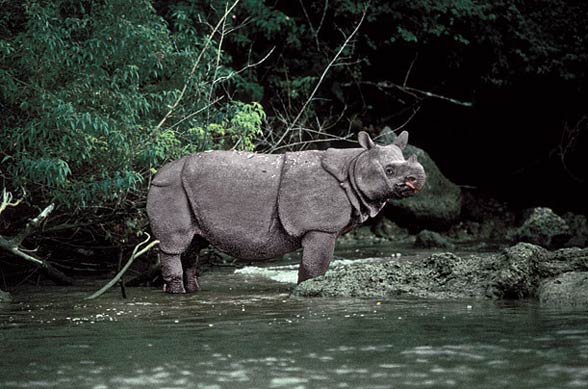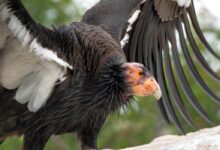Javan rhinoceros (Rhinoceros sondaicus)
The Javan rhinoceros is critically endangered nowadays. There are two populations of these animals living in the world and the total amount does not exceed 100 rhinos.
It is easy to distinguish it from the white rhinoceros because it is smaller and its horn on the foreface is single and short. However, its character has a lot in common with the African rhinoceros although there are a few differences between them. Let’s find out more about the next representative of rhinoceros and this time, it is the one coming from Asia.
Classification
- Kingdom: Animalia
- Phylum: Chordata
- Class: Mammalia
- Order: Perissodactyla
- Family: Rhinocerotidae
- Genus: Rhinoceros
- Species: Rhinoceros sondaicus
Subspecies and their distribution:
Among three distinct subspecies, only two have survived till today.
The Vietnamese rhinoceros (Rhinoceros sondaicus annamiticus)
It lived in Vietnam, Laos, Cambodia, Malaysia and Thailand. In 2006, its population was 12 species which lived in the area of Vietnamese National Park-Cat Tien. The last representative of these subspecies was shot by a poacher in 2010.
The Indian Javan rhinoceros (Rhinoceros sondaicus inermis)
It lived on areas ranging from Bengal to Burma but the species was considered extinct in 1925.
The Indonesian Javan rhinoceros (Rhinoceros sondaicus sondaicus)
The typical subspecies living in Java and Sumatra, but today’s population has been confined to about 40 species in the wild staying only in Javan National Park-Ujung Kulon.

Habitat
In the past, it was commonly seen in Assam and Bengal where the population of the Javan rhinoceros overlaps the population of the Indian rhinoceros. Apart from terrains mentioned above, it could also live in Borneo.
The main habitat of these species is dense lowland rainforests, meadows, rushes adjoining big reservoirs or swamps. Although it primarily preferred lowland areas because of people’s interference and poaching, it had to move to upper terrains.
Appearance
Size
Its size is similar to the black rhinoceros – the length of its body is between 2-4 meters (6.5-13 ft) and its height at shoulders is 1.4- 1.7 meters (4.6-5.6 ft), its weight is questionable – it is estimated approximately 900-2300 kilos (1984-5071 lb) although there have not been any exact measurements carried out as it is not the priority within the species which are almost extinct. Nonetheless, it is known that the gender dimorphism is slight if we take into consideration its growth. Females, however, are supposed to be bigger. On the basis of photos and traces, it has been shown that species in Vietnam are bigger than those in Java.
The horn
Similarly to the Indian rhinoceros, it has one horn on the foreface which is the shortest of all rhinoceros species- it is less than 20 cm (7.9 in) long and the biggest registered horn was only 27 cm (10.6 in). Only males have this feature whereas females have small bumps. Rhinos having horns do not use them too often to fight but to scrape mud away, pull down plants which they eat or to make trails through thick brushes.
The foreface
The upper lip is long and pointed, therefore, it helps to grab twigs. It has got low incisors in the foreface and they are long and sharp (because of that, they are used while fighting with the opponent). Behind incisors, there are molars which are used for crushing and chewing coarse plants.
Senses
The other feature which connects the Javan rhinoceros with other relatives is a great sense of smell and hearing, but the vision is very poor.
Skin
The skin is hairless, gray or gray-brown and there are big skin folds on shoulders, back and rump. The skin has the natural mosaic pattern; therefore, the animal looks like an armored vehicle. The neck folds are smaller in comparison with the Indian rhinoceros but it does not change the fact that they form a saddle shape.

Diet and behavior
It is not surprising that the Javan rhinoceros is herbivorous. It mainly eats rushes, twigs, young leaves and fruit. The majority of these plant species appear on areas with plenty of sunshine. The rhinoceros knocks down saplings with leaves and twigs using a mobile pointed upper lip.
It has a solitary lifestyle with the exception for the oestrus and the time when mothers take care of calves. It happens that animals meet near the mud or water reservoir to wallow there. This behaviour is the characteristic feature of all rhinoceros- the mud on the body helps to keep the low temperature, prevents diseases (mainly parasitic ones), irritations and sun burns. To feel the pleasant mud cool, animals do not form their own mud areas but they prefer using natural swamps or the ones created by other species.
It needs salt to live and it can drink sea water to fill the shortages in the body (there are no salt licks in Ujung Kulon National Park).
Males have bigger areas which have the size of 12 to 20 km2 (4.6 to 7.7 mi2) whereas females are enough to have the area of 3 to 14 km2 (1.2-5.4 mi2). The ranges of males overlap less the ranges of females and it is unknown if they fight for them. Male rhinoceros mark the range with their dung piles and urine. The ground and the bark are marked with their footprints. This second technique can be the form of interspecies communication.
Comparing to the Sumatran species, the animal described in our article is rather silent- there are few recordings of its voice abilities.
Adult species do not have enemies apart from humans. The Vietnamese subspecies is the most skittish- when it spots people, it escapes deeply into the forest. Although this feature helps it survive, it is really disturbing while trying to observe it and doing some research. It can be said that the Javan rhinos do not like humans so much that they can become aggressive and offensive if somebody comes too near them. It is not excluded that such behavior is connected with the aggressive way of destroying forests and overpopulation. Some evidence shows that in the past rhinos were much more friendly.

Dying out
The population of the Javan rhino has been decreasing for at least 3000 years. Since approximately 1000 BC, the northern Chinese range of distribution was falling at 0,5 km (0.3 mi) every year which was connected with the appearance of more settlements for people. Since the first decade of XXth century , the species has been supposed to be extinct in India.
In 1932, animals disappeared from Malaysian Peninsula and at the end of the Vietnamese war, it was believed that it completely died out on the area of continental Asia. Aboriginal hunters and loggers from Cambodia stated that they saw rhinos in Cardamom Mountains but observations of those areas did not confirm these revelations. In 1980s, a small population of rhinos was found in the Vietnamese National Park, Cat Tien. It is possible that a small group of rhinoceros lives in Borneo although they may be the Sumatran rhinoceros.
Detailed information and size:
Javan rhinoceros (Rhinoceros sondaicus)
- Body length: 2-4 m (6.6-13 ft), average: 3.1–3.2 m (10ft 2in–10ft 6in)
- Height at shoulders: 1.4-1.7 m (4ft 7in-5ft 7in)
- Weight: 900-2300 kg (1,980-5,070 lb)
- Horn: to 20 cm (8 in), max. 27 cm (11 in)
- Lifetime: 30-45 years (maybe 40-50 years) in wild. In the zoo, it lived up to 20 years.

The Javan rhinoceros – interesting facts:
Name
The Latin name of the Vietnamese subspecies comes from Annamite Range (south-east Asia) where these animals lived.
The part of the Nasalis rhinoceros name ‘ inermis’ means ‘ defenceless/without the weapon’. It is connected with a small horn on the male foreface but the female lack it completely.
The second animal after the Indian elephant in Asia
The Javan rhinoceros is the biggest animal in Java and the second one considering its size in Indonesia after the Indian elephant.
How much does the Javan rhinoceros eat?
The Javan rhinoceros eats 50 kilos (110 lb) of vegetation daily.
Mobile lips
The Javan rhinoceros has the most mobile and flexible lips among all rhinoceros species.
Non-invasive research
So as not to unnecessarily stress these giant mammals, scientists’ researches are mainly based on the feces samples and installed cameras. However, they are scarcely seen and therefore, it is difficult to track them.
Small population
It is estimated that there are less than 100 species of these animals in wild (positive version).
There are no Javan rhinoceros in zoos
There have not been any Javan rhinoceros in zoos for more than 100 years. In XIXth century, there were at least four species living in zoos in London, Adelaide and Calcutta. There have been at least 22 Javan rhinoceros registered in captivity although this number was rather much higher as these species were widely mistaken with the Indian rhinoceros.
The Javan rhinoceros did not manage well in captivity.. The oldest animal lived only up to 20 years and in the natural habitat, it could live up to 50 years. The last representative of these species in captivity died in 1907 in the zoo in Australia where it was mistaken for the Indian species.
The long and expensive programme of the Sumatran rhinoceros reproduction in zoos, which was realized in 1980s and 1990s, was not successful and efforts to save the Javan rhinos in zoos were abandoned. Little hope is given to the population living in wild. However, little genetic changeability within species makes these hopes vain.

Recommended
- Rhinos
- Sumatran rhinoceros
- Woolly rhinoceros
- Arsinoitherium
- Elasmotherium
- Animals & dinosaurs records
- The fastest animals – Top 100
- The fastest birds – Top 10
- The heaviest dinosaurs – Top 10
- The longest dinosaurs. Sauropods Top 10
- The longest predatory dinosaurs. Theropods Top 10
- The heavies predatory dinosaurs Top 10
- The longest and largest ornithopods
- The longest and largest ceratopsians
- The shortest sauropods
- The smallest dinosaurs – Top 10


















